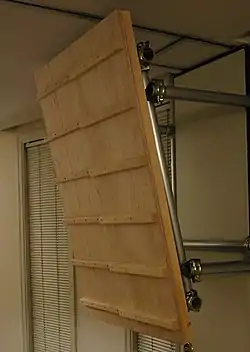Campus board
A campus board is a training tool that has been widely adopted to improve rock climbing performance. Typically, a user ascends or descends the campus board using only their hands.[1] Campus boards can take a variety of different forms and may incorporate a variety of materials. As one example, a campus board may comprise horizontal thin slats or rails of wood attached to an inclined board in a ladderlike configuration. However, some implementations may utilize bolt on climbing holds or sections of pipe. A campus board is generally set at overhanging angle of inclination that is between vertical and 20 degrees. One consideration for selecting the angle of inclination is the avoidance of any interference that may result between the user's legs and the campus board or wall.

The campus board was invented by Wolfgang Güllich in 1988 while he was training for a new route, Action Directe, which requires extreme dynamic finger strength. The first campus board was hung at a university in a gym called The Campus Centre.[2][3] Hence the term "campus" has been applied to the name of the training board, training method, and style of climbing, or "campusing" in which only the user's hands and arms are used. In French and in Italian, the campus board is referred to as pan Güllich.
There are a variety of training approaches that may be used with a campus board, but all of them are centered around the concept of Plyometrics training. As one example, a user may alternate the use of specific fingers to increase finger strength when ascending or descending the board. As another example, upper-body strength may be increased by utilizing large lunges between specific rails or holds of the campus board (Power throws). Reactive training may be used to increase muscle recruitment rates by dynamically moving between the campus board rails simultaneously with one or both hands. Training on a campus board may result in better performance due to the improvement of motor training, increased finger strength on a variety of grips, and greater power and lock-off strength of the arms.
The campus board has been a topic of controversy especially for newer climbers, as it risks causing injuries to the climber due to improper technique or fatigue. As such, the campus board is usually never recommended to climbers who are new to climbing.
References
- Academy, U. S. Sports (2016-06-24). "Analysis of Contemporary Anaerobic Sport Specific Training Techniques for Rock Climbing". The Sport Journal. Retrieved 2019-12-14.
- "The Campus Board" (PDF). Metolius. Retrieved 2016-04-24.
- Samet, Mike (2011). Climbing Dictionary. Seattle, WA: The Mountaineers Books. p. 46. ISBN 978-1-59485-502-3.